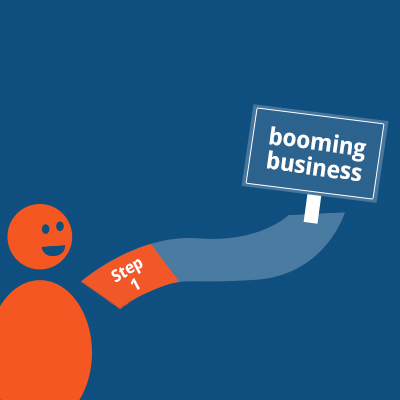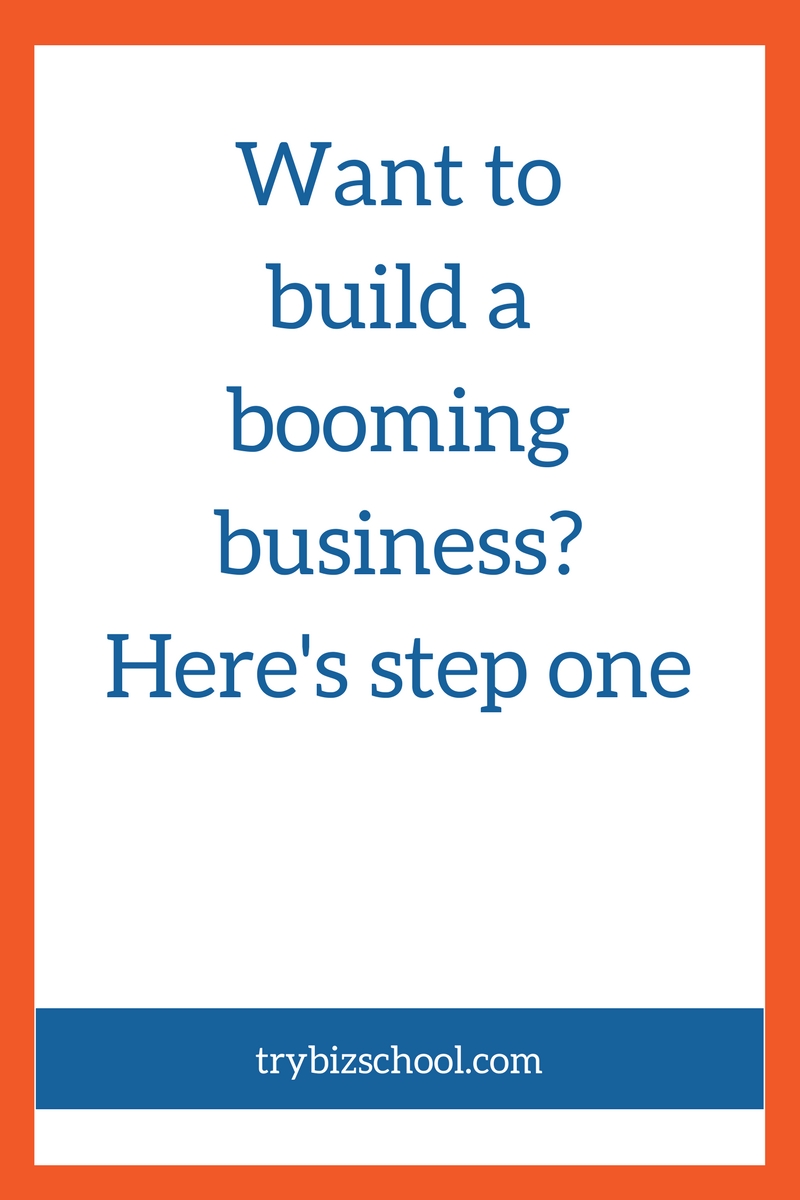Now what do I do?
Have you ever asked yourself that question? When it comes to building your business, have you ever felt like you needed someone to point you in the right direction? Someone to get you on the path to doing great things?
That’d be wonderful wouldn’t it?
To have a guide. A compass. Something or someone who whispers in your ear the next step you should take to get you from where you are to where you want to go.
Building a business is a lot of work. Figuring out how to build a business that thrives is even more work. It seems there are endless moving parts that all need to work together. And at the right times.
All so your business can run like the well oiled machine you’d like it to be.
The good news is you can have a guide. And it will absolutely be there to lead you along every step of your journey.
But it requires you to take the right first step. No matter how far along you are in your business, investing time to get this step right is essential.
How to make it to the Promised Land
“I just want to do God’s will. And He’s allowed me to go up the mountain. And I’ve looked over. And I’ve seen the Promised Land.” – Martin Luther King, Jr.
Michael Phelps sat in an office with his mother, his agent, and his long-time swim coach Bill Bowman.
It was two years before the Beijing Olympics. They were talking about expectations and how he wanted to pursue the upcoming games.
That’s when Phelps made his intention clear.
“I want to be the best ever.”
Bill Bowman talks of his reaction to Phelp’s declaration:
“And when he said those words it was like a bomb went off in my head, about what I needed to do…I knew exactly where we were headed, I knew what were going to do, and I knew what kind of big mountain we were going to climb.”
Two years later, Michael Phelps won six medals to become the most decorated Olympian of All-time. If you judge by medal count, with twenty-two he is the best-Olympian ever.
Mission accomplished.
Michael Phelps declared his Promised Land. Then he worked with his coach to climb the mountain that would take him there.
You should do the same.
If you want to build a business that thrives, the first thing you need to do is define what success looks like. You have to declare what your Promised Land is.
Only then can you figure out which mountain to climb to get you there.
The first step in getting to your Promised Land
The notion of visualizing what you want to do before moving forward isn’t new.
Stephen Covey covered it in The 7 Habits of Highly Effective People. He refers to the concept as beginning with the end in mind.
“To begin with the end in mind means to start with a clear understanding of your destination. It means to know where you’re going so that you better understand where you are now and so that the steps you take are always in the right direction.”
It was also addressed from a different angle in the classic children’s book, Alice in Wonderland:
“Would you tell me, please, which way I ought to go from here?”
“That depends a good deal on where you want to get to,” said the Cat.
“I don’t much care where–” said Alice.
“Then it doesn’t matter which way you go,” said the Cat.”
When you know what your destination is, it does matter which way you take. It does matter which mountain you climb.
And when you follow the path that leads to your business’ promised land, there’s a whole lot less wandering around.
In business, your Promised Land is also known as your mission or purpose.
But many entrepreneurs skip the step of defining their purpose. Others do it half-heartedly, without giving it the proper thought this exercise requires.
According to Peter Drucker, the father of modern-day-business management, skipping this step can actually doom your business.
“That business purpose and business mission are so rarely given adequate thought is perhaps the single most important cause of business frustration and business failure. Conversely, in outstanding businesses…success always rests to a large extent on raising the question, What is our business? clearly and deliberately, and on answering it thoughtfully and thoroughly.”
The idea may not seem like rocket science, but it’s critical to your success. Here’s how Bill Bowman defined the benefits of declaring your mission:
“The dream establishes the forest, and then we start looking for the trees. It let’s you know where we’re going, what direction we are headed. That’s what the dream gives you. And it does get you out of bed on those cold mornings.”
And there will be plenty of cold mornings.
Your mission will get you out of bed. It will point you in the right direction. And it will keep you from wandering away from the path to your Promised Land.
But you’ll only get these benefits, if you adequately define what your purpose is.
How to answer the most important question in your business
A lot of times when entrepreneurs try to define what their business is, they go about it all wrong. That’s because, they define their business goals around what they want.
I want to be financially free.
I want to be location neutral.
I want to share my gifts with the world.
While those are all great goals, they are personal goals. You should totally write them down as you’re designing what the good life looks like for you.
But personal goals aren’t why your business exists. In fact, your business’ reason for being isn’t about you at all.
Your business is for your customer. It exists for the people you serve. Here’s Peter Drucker on the subject:
“With respect to the definition of business purpose and business mission, there is only one such focus, one starting point. It is the customer. The customer defines the business. A business is not defined by the company’s name, statutes, or articles of incorporation. It is defined by the want the customer satisfies when he or she buys a product or a service. To satisfy the customer is the mission and purpose of every business. The question, What is our business? can, therefore, be answered only by looking at the business from the outside, from the point of view of customer and market. All the customer is interested in are his or her own values, wants, and reality. For this reason alone, any serious attempt to state “what our business is” must start with the customer’s realities, his situation, his behavior, his expectations, and his values.”
“Who is the customer? is thus the first and most crucial question to be asked in defining business purpose and mission. It is not an easy, let alone an obvious, question. How it is being answered determines, in large measure, how the business defines itself.”
In other words, your customer is the center of your universe.
Three exercises to start moving your business in the right direction
Since your customer is the focal point of your business, what you do for her is the key to getting to your promised land.
So you’ve got to have intimate knowledge of who your customer is. You’ve got to know what her dreams, desires, fears, and frustrations are.
To help you with figuring all that out, here are three exercises to work through.
(In the coming weeks, we’ll explore each of these more in depth).
1. Identify your ideal customer
Who is the ideal person your business will serve? The more descriptive you are as you define this, the easier your efforts will be moving forward.
To do this, avoid define your ideal customer purely based on demographics, such as “single women aged 34-49.”
Think more of people who have a similar desire, burning pain, or unifying characteristic.
Examples
People who are planning to move abroad within the next 12 months
Women who’ve just given birth
Recent college graduates with a boatload of student loan debt
Exercise
Grab a sheet of paper, and write the down the unifying mindset or circumstance of your ideal customer.
2. Define your customer’s problem
What challenge does your ideal customer want to solve when she is buying your product?
When a person makes a purchase, they’re either buying good feelings or a solution to a problem. So you’ve got to define the problem the way your customer thinks about it.
Examples
People who are planning to move abroad in the next 12 months, that need to figure out how to relocate their pets
Women who’ve just given birth, that want their baby to sleep through the night
Recent college graduates who’d like to pay off their student loan debt, sometime before their 67th birthday
Exercise
Grab that sheet of paper again. How does your customer think about her problem? Write it down.
3. Decide how you’ll solve your customer’s problem
In building your business, you’ve got a blank sheet of paper. But the challenge that comes with having a blank sheet of paper is focusing enough to not try to do everything with it.
So when defining what your business is, you do it by focusing on how you’ll solve the problem your customer has.
We facilitate all the steps needed to relocate a pet to a new country, so you can focus on other aspects of your move
We train moms how to sleep train their babies so everyone in the house can rest well
We educate and train recent college grads on how to pay off student loan debt while living a rich life
Exercise
Now it’s your turn. How does your business solve the problem your ideal customer feels they have? Write it down on your paper.
No more roaming around
It’s time to get to your Promised Land.
But to do that, you have to get on the right path. You’ve got to take the first step in the right direction.
Your mission will tell you which projects to work on. It will tell you how to spend your limited resources. It will get the right people on your team.
Your mission will be your guide.
But only if you invest the time to create a purpose so clear that it leads you up the right mountain.
And to your Promised Land.







